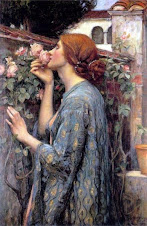SOVA Espresso Bar
I'm in one of those Bohemian-rhapsody coffee shops in an up-and-coming neighborhood on H Street. The upstairs corner window overlooks an urban night landscape of line and dark ruined by electric color. The floor is rich, dark, battered wood. Track lighting looks askance at painted Corinthian columns fluted on a bias. Mismatched ladderback chairs line up against the walls, interspersed with bordello-red velvet setees.
My masala is weak. Mallie types on her Mac, one thumb flexed between her lips and her nose, and I set my mug aside in favor of getting I can some work done. For two weeks, I have been staring at some very bad penmanship in my notebook called "Notes for a Blog," and it's time I did something about it.
The Saturday after Christmas, Bethany and I had a post-Nativity/pre-Epiphany gift exchange (I gave black bedroom slippers and got a red teapot), and we went to see the Edward Hopper exhibit at the East Wing of the National Gallery of Art downtown.
I have heard Hopper singled out as an "American painter," though I suspect that after some Inuit cave paintings, the ideal of a pristine American art, somehow immune from external influence, is an elusive, if not humbug notion. To his credit, or perhaps to that of his most effusive critics, Hopper delivers the warm approximation you would hope for in a boy born in Nyack, New York at the wane of America's Gilded Age.
I sat on the spare, black bench in the middle of the viewing room amid crowds milling from canvas to canvas, trying with conspicuous good breeding not to block one another's view. The gallery was overcrowded, a testament to Hopper's elevated status as a national commodity. The walls were the color of a gray flagstone, and oddly perhaps, for an art gallery, I found my eyes sinking to the industrial-grade carpet, and studying the hesitant traipsing of gallery shoes, sensible, low-heeled, and with laces. The clock showed two hours past noon. I'd had nothing to eat. Hunger pangs stunted my attention, but weren't without benefit.
In addition to his classic Americanism, much has been said of Hopper and the loneliness of his work. Without overstating a tired point, Hopper does dole out a certain restrained insecurity, and sharpened perhaps by physical appetite, I itched to have something in my fingers' grasp, another human hand to cling to, and despaired that I should not find one if I reached.
Hopper's greatest virtues as an artist are his ability to capture light and mood, particularly the drama of a vacuum, the pregnant silence, the pause in conversation after something devastating has been said, the isolation of unconfessed love. All this somehow lurks, and gives to his pieces a voyeuristic energy, the inherent excitement of bare plausibility, which is enough all by itself to lift the pulse of a gossip-drunk social mammal. In his pictures I see widows, frames, curtains - frames within frames, and the addictive frustration of knowing that the more I see, the less is revealed. They say Hopper painted life as he saw it from the window of a commuter train.
Hopper's buildings lack perpendicularity. His perspective is more-or-less. His nudes, especially the women, have plaster-of-Paris necks and breasts of Styrofoam. Whether this can account for it, I don't know, but he modeled his female subjects after Mrs. Hopper, who could not even have been called handsome. Hopper's imagination has altered but not improved her angular "off-ness," innovations in a baseline distortion. I can hardly fault him. On reflection, Michelangelo's early women had that same garish masculinity, that takes but a moment to strike you but several more to be understood.
For me, the light redeemed all, if indeed there were any redemption required. Its quality was . . . all that I might have hoped for light to be, clear, either with the skinflint radiance of a winter solstice, or the light of a bulb in a cheap motel in 1930, or the light of the northern latitudes when the sun has just bested the treeline, or the white light of a port town at noon, that grabs the sun and hurls it back from sand and wave and sail.
I stopped in the museum shop on the way out. I bought a postcard of "Chop Suey" for Michelle that I am strongly tempted to keep, except that now I've stated my intention publicly, and she might read it.
All Clear!
-
Of all the memories, experiences and things I brought back from Uganda, I
have managed not to bring Malaria with me. I was so happy I had to share it
with ...
16 years ago






No comments:
Post a Comment